While Pass Labs bares founder and chief designer Nelson Pass’ name, his business partner, Wayne Colburn, is responsible for the company’s elaborate line-level preamplifier designs. First, let’s clarify the terminology: this type of component is often called an audiophile stereo preamplifier, line stage, line stage amplifier, or line stage preamplifier. Many manufacturers and media companies use the terms interchangeably regardless of feature set. More specifically, a line stage is a preamplifier without a phono stage (which is a specialized input that allows ultra-low voltage turntables to be connected to the preamplifier).
The Pass Labs lineup inclines four line-level preamplifiers in total. The three upper-end models distinquish themselves by separating the power supply from the gain stage with two- or three-component configurations. The entry-level XP-12 is a single-chassis design and the subject of this review. Borrowing several areas of design and circuitry from the multi-chassis, top-to-the-line Pass Lab XS line stage preamplifier, the XP-12 is the ultimate expression of trickle-down technology. With a retail price of $6,100, the it provides a good taste of the uber-sophisticated XS line stage preamplifier for a fraction of the price.
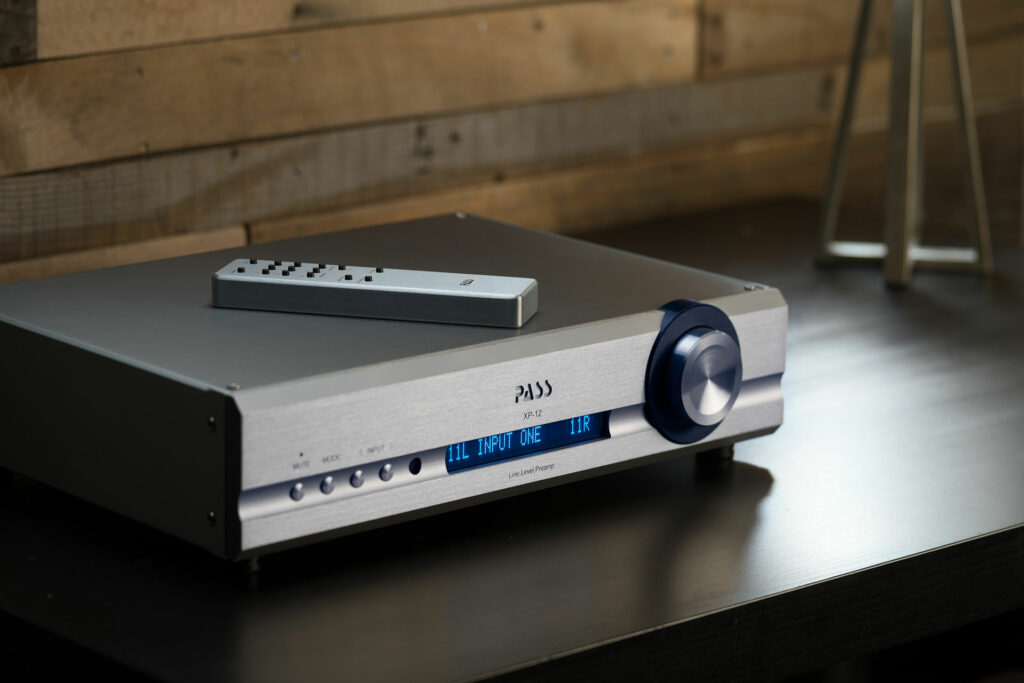
The XP-12 was initially introduced in 2017, which is an eternity ago by typical consumer electronics standards. However, in the high-end world, it is common for products to stand the test of time, only being upgraded when something substantial changes, which warrants a new product model.
Preamplifiers are often overlooked as they are not the sexiest of audio components compared to an audiophile amplifier that creates the power or visually compelling floorstanding speakers. But I offer caution since a poor-performing preamplifier can drastically and negatively impact your system. Case in point, many years ago, I upgraded my speakers only to realize upon listening to them in my home that they lacked the transparency and emotion I had heard during my in-store audition. I continued to upgrade the amplifier, which offered improvements, but my system still lacked the visceral performance I had experienced during my store demonstration. Removing my preamplifier from the system was suggested, taking the source, a Compat Disc player, directly to the amplifier, and voilà … success at last! The amplifier and speakers came to life so substantially I lost sleep that night, simultaneously experiencing both astonishment and accomplishment as I could not believe the noise, distortion, and layer of obscurity my original preamplifier was imparting to my overall system.
Preamplifiers can also affect the frequency response, imaging, soundstage depth, and width. Some may call this a sonic signature that alters the original recording. Others suggest that the preamplifier can more successfully pass a more linear and extended frequency response that exists on the original recording. While we will not solve this debate here, we can all agree that a revealing preamplifier allows other components in your system to display their full capabilities. Let’s dig in deeper to see what the Pass Labs XP-12 offers.
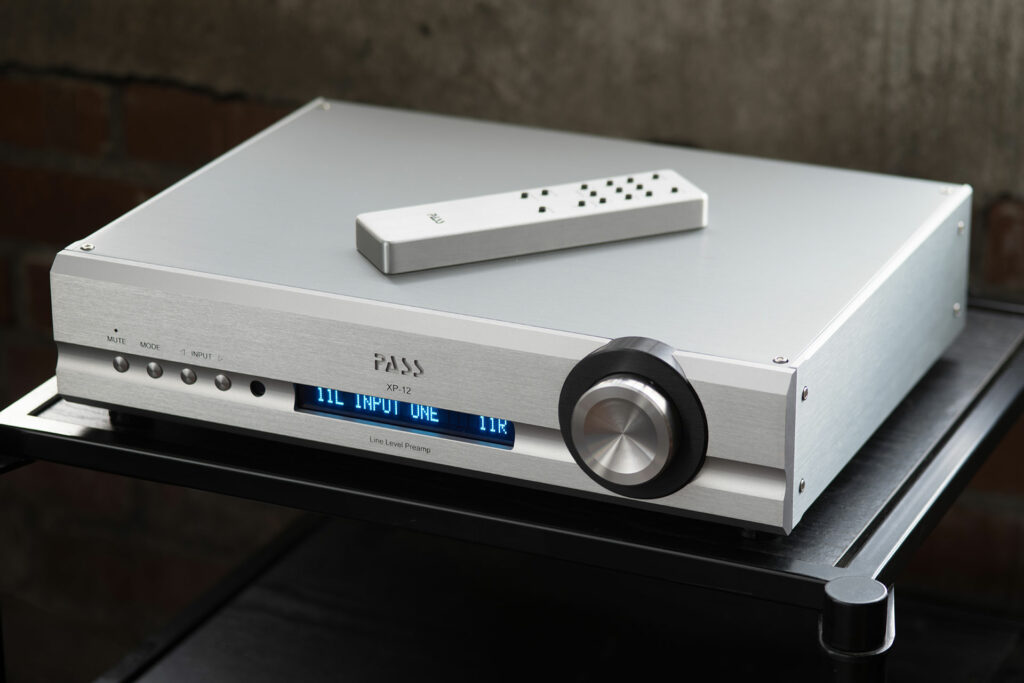
What Makes the Pass Labs XP-12 Preamplifier Special?
- The Pass Labs XP-12 has an updated toroidal power supply with enhanced mechanical and electrical isolation, with an improved but complicated circuit design that lowers noise and increases filtering over the previous model.
- The Pass Labs XP-12 benefits from a micro-controlled single-stage volume system – borrowed from Pass Labs’ top XS preamplifier model, which retails for $38,000 – that offers one hundred steps of attenuation in one-decibel increments.
- It features five source inputs, two balanced and three single-ended, with one input offering home theater pass-through, allowing the Pass Labs XP-12 to be integrated into an existing home theater system easily.
- A solid aluminum remote controls both source selection and volume and activates the trigger output to turn on the amplifier(s) if connected.
- Aesthetically, the Pass Labs XP12 is an attractive component that follows the form factor of other Pass Labs components, with a thick aluminum face plate and a black-trimmed volume control.
Why Should You Care About the Pass Labs XP-12 Preamplifier?
A few components within your system should be buy-once-cry-once products, meaning get it right up front and you won’t need to fiddle with it later. Amplifiers and preamplifiers are good candidates for this category. Since the Pass Labs XP-12 is a highly conceived and well-designed preamp, keeping the features simple and focused on the task at hand, it puts its chops into the solid basics of a line-level preamplifier with a sophisticated design, esoteric parts-selection, and an extreme volume control, making the preamplifier ultra clean while providing complete frequency response and vivid imaging. This should be the goal of all audio enthusiasts and the Pass Labs XP-12 delivers on this agenda in spades.
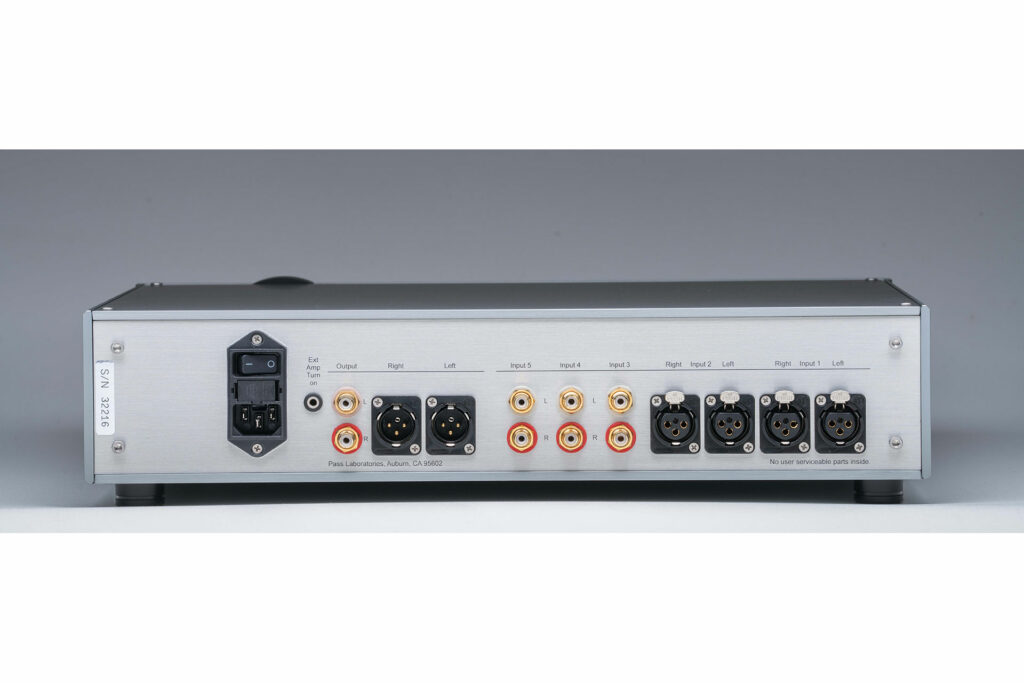
Some Things You Might Not Like About the Pass Labs XP-12 Line Stage Preamplifier…
- By design, the XP-12 favors simplicity over a multi-tool concept. In other words, it lacksadditive features like a streaming DAC, headphone amp, or phono-stage input. Many competing products will include these features; however, consumers should be concerned about how well these ancillary add-ons will work. The inclusion of such features, while convenient, are afterthoughts rather than high-end offerings that would impact the preamplifiers’ primary purpose. Some consumers may have no need for such functionality. The thought process here is that these additional built-in products are better suited as separate external components where consumers can customize and prioritize their requirements and choose how extreme they want to go with these features. However, a compact preamplifier with built in features is convenient, and if that is your goal, you will need to look elsewhere.
Listening to the Pass Labs XP-12 Preamp…
I connected a BlueSound Node music streamer using line-level RCA connections and relied exclusively on my Tidal streaming subscription as the source for this review. Amplification was provided by Pass Labs XA60.8 monoblock amplifiers, which were wired to a pair of Focal Kanta No. 2s floorstanding speakers. I streamed an incredible amount of music over an extended period, but settled on two tracks that displayed the XP-12’s extraordinary transparency and dynamic range well.
The album GRP30: The Digital Master Company 30th Anniversary showcases various painstakingly recorded artists that display high-resolution with an extended dynamic range. I settled on the track “People Make the World Go Round,” which is mainly instrumental but exquisitely exhibits the higher frequencies of a piano, with the lower notes of a bass guitar that shows off the audio system’s capabilities. Imaging was large, comprehensive, and deep, carefully and intelligibly placing instruments where they belonged while floating in front and behind the speakers without creating fatigue.
On Aaron Neville’s album Warm Your Heart, “Everybody Plays the Fool” is very well-recorded despite being released in 1991. Neville’s higher-octave vocals contrasting with lower notes of bass guitar and percussion demonstrate the tonal balance of the XP-12. I was reminded how well this system’s parts played together, showcasing amplification and speakers alike. Again, the soundstage continued to float in the room in an organic, airy way, making me want to listen.
To put the Pass Labs XP-12 to an additional test, I bypassed it by connecting the Bluesound Node directly to the amplifiers to hear how it would perform and if I would notice a difference with the XP-12 out of the system. With the same tracks, I could not discern any less noise or increased clarity, which I expected since the XP-12 is well thought out and designed. However, I noticed a decrease in the radiance of the midrange and lower bass notes, with less projection into the listening area, while imaging was less impressive. Additionally, with the XP-12 connected, I found that listening at lower volumes was more pleasurable because some of that extended bass response was retained, and imaging did not collapse when compared to the Node connected directly to the amplifiers. This should not be construed as criticism of the $599 Bluesound Node; it is a surprisingly high-performing streamer with some preamplifier functionality (it seems that they all do). I would not expect such a device to compete with a separate painstakingly designed preamplifier like the XP-12.
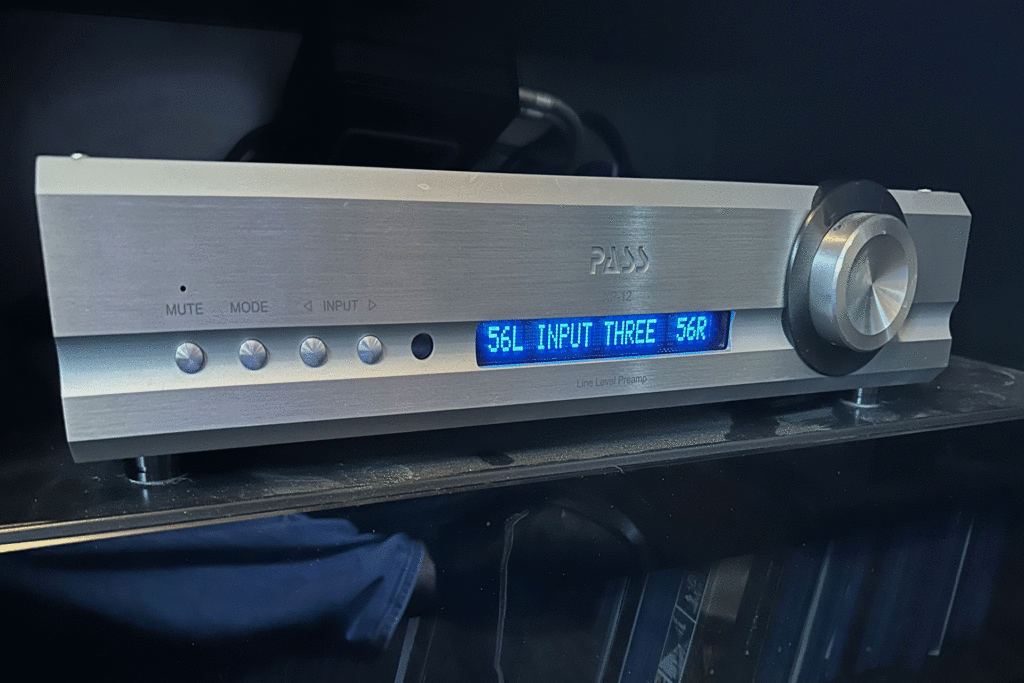
Does the Pass Labs XP-12 Line Stage Preamplifier Hold Its Value?
Since its release, the retail Price of the Pass Lab XP-12 has gone up, but that is the case for most products these days. I have said before that normal depreciation should be expected on audio gear. Still, I suspect that the depreciation on the Pass Labs XP-12 will be less than most preamplifiers in this category due to higher demand and timeless design.
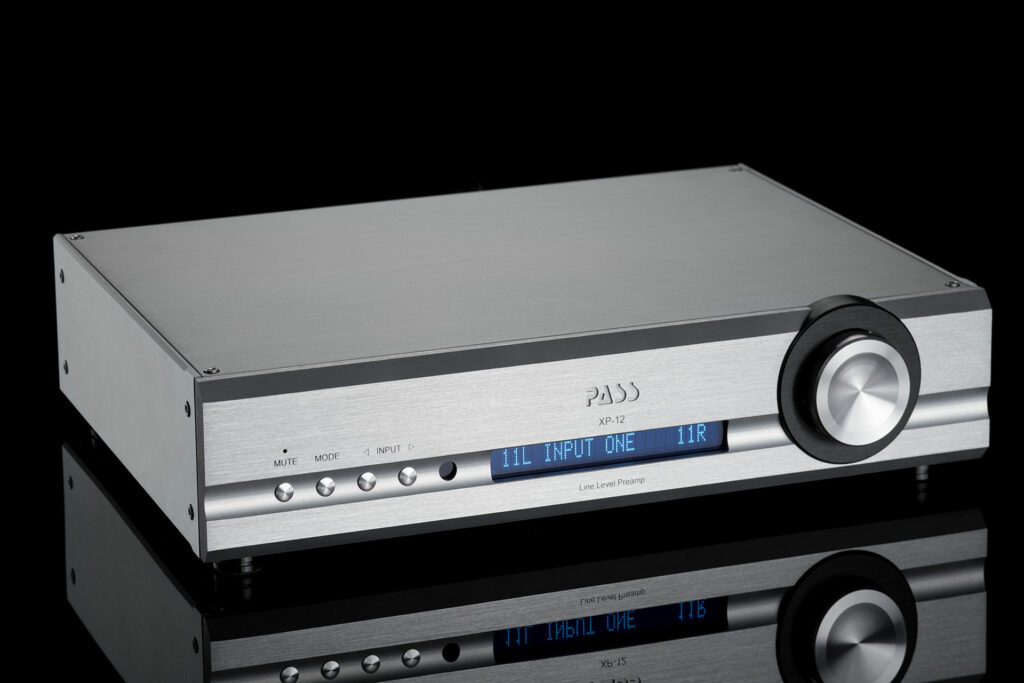
What Is the Competition for the Pass Labs XP-12 Preamplifier?
The Bryston BR-20 preamplifier is a highly featured product with a base price of $5,995. It includes the company’s best preamplifier technology with a sophisticated internal DAC plus Bryston’s proprietary streaming platform, as well as a headphone output. For an additional $1,000, a phono stage can occupy an RCA audio input. Lastly, for $1,200, an HDMI input can be added, which is a really nice option seen on few audiophile preamps today. The HDMI connects a silver disc player (SACD, Blu-ray, DVD-Audio etc…) or streamer like an Apple TV or Roku. Fully loaded, the Bryston BR-20 would be priced at just under $8,200. As discussed earlier, there are pros and cons when a preamplifier combines other components, and only you can decide which path is right for you. But if you choose to include some or all of these built-in features, the Bryston BR-20 could be a consideration.
The PrimaLuna EVO 400 is the company’s top-of-the-line all-tube preamplifier (as opposed to solid-state transistors as in the Pass Labs XP-12). The EVO 400 retails for $5,295 and comes with a solid build and innovative design at a price lower than competing models. PrimaLuna winds their toroid power transformers to provide low hum and electromagnetic interference (EMI) with an AC offset killer for lower noise. High-quality, expensive parts are used throughout, including Takman resistors and AR4 rectifier tubes – two per channel. The entire design, from front to rear, is a dual-mono configuration for increased three-dimensionality. PrimaLuna prefers using the ALPS Blue Velvet analog volume control over microprocessor control digital designs, which goes hand-in-hand with their all-tube philosophy. Point-to-point wiring using Swiss-made silver-plated OFC cable in all areas of the audio signal is another commitment not often used in today’s tube amplifiers but is present in the PrimaLuna lineup. The outlandishly overbuilt chassis weighs in at 53 pounds, which is heavy for a preamplifier. PrimaLuna prefers an outboard headphone amplifier and phono stage like the Pass Labs. While I have not had the opportunity to experience this preamplifier, I have had some exposure to Prima Luna’s other preamplifiers with impressive results. Given that the price point is slightly lower than the XP-12, an audition may be worthwhile.
The Aesthetix Calypso is a line-level preamplifier designed and manufactured in the United States. It featgures a dual-mono design, fully balanced on the five XLR or line-level inputs to output, with an all-tube amplification design from input to output for the audio signal, but combining solid-state electronics for the control. Two audio outputs in either XLR or RCA formats provide convenient integration with existing components in a bi-amplification configuration. The president and designer of Aesthetix, Jim White, was head designer at Theta in a past life, with an in-depth background in solid-state design. The Calypso is a single-component design with an ample power supply, high voltage choke, and heater transformer with all-magnetic components shielded in a steel cover. High-quality parts are used throughout. There are three versions of the Aesthetix Calypso: Standard ($6,000), Signature ($8,500), and Eclipse ($12,000), with each level furthering the sophistication of components within the unit. In the basic form, the Calypso is priced almost identically to the Pass Labs XP-12, with features such as a home theater bypass and an included remote control for convenience.
Final Thoughts on The Pass Labs XP12 Line Stage Preamplifier…
The XP-12 is a bold reminder of how vital the preamplifier is to an audio system. With ultra-transparency, low noise and distortion, and fantastic frequency response and dynamic range while providing the delicate and critical tasks of source switching and volume control, the Pass Labs XP-12 performs precisely. With an extraordinary build quality, parts, and thoughtful design, with everything you need and nothing you don’t, the XP-12 is a long-term, if not lifetime, component. It acts like a canvas for a painting, providing the backdrop and support of the audio image, bridging more interesting components like sources, amplification, and speakers, creating one highly performing system. If your rig lacks that special something, consider doing the bypass test described earlier. If the outcome suggests a preamplifier upgrade is in order, the Pass Labs XP-12 should be your first consideration – it is that good.




Sorta tired of blue displays. They are so nineties.
Sounds like a personal problem
I think every GenXer in the world is tired of blue light at this point in our lives. 🙂
I still use Pass’ predecessor, the Aleph P, as a ref pre. Its single gain stage has enough oomph to drive phones, its clackety relay-driven stepped attenuator and SEPARATE L7R gain controls allow ersatz balance control extremely precisely and invisibly. It easily resolves subtleties of spatial information in my cable development as ArgentPur without any coloration. I would expect its modern iteration to perform at least as well.
I reviewed the XP-22 but it hasn’t run yet but it will soon.
It isn’t a fancy preamp like the Classe Delta PRE with a bad ass DAC and HDMI and tone control but it sounds(ed) SO SO SO GOOD.
I lent to to Brian Kahn (long standing reviewer) who lives about 30 miles from here. He’s taking a quick listen and Greg Handy is going to compare it to the XP-12 which he owns. I hope he chokes so that I can have it back.
I can’t remember a product that I missed more after taking it out of my system.
“Pass Labs bares founder and chief designer Nelson Pass’ name” – I think you meant “bears” rather than “bares”